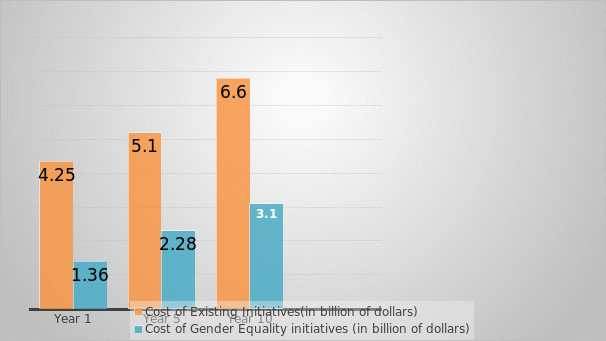Introduction
In September 2015, the story of Tara Brown as reported in the ABC Press left readers astounded. Brown had been assaulted to death by her spouse, an ex-biker. According to Tapim (2015), Brown had recorded domestic violence issues to the police. Unfortunately, she met her death before the detectives could curtail the threat. This essay focuses on the topic ‘Domestic Violence against Women’. The goal is not only to demonstrate the weight of the issue but also to investigate how the mischance can be curtailed. The discussion is important since domestic violence has caused psychological and physical injuries to women who have in turn become a burden to the economy as it has to dedicate resources to address the issue. The ensuing discussion points out why promoting gender parity may be the most effective way of preventing and discouraging domestic violence against women.
Problem Analysis
The link between domestic violence against women is intricate. Such violence seems to have its roots in the patriarchal ethos that has formed most parts of various societies in the world. These masculine principles have overlooked the place of the woman in society to the extent of excluding the latter class when developing statutes, organizational guidelines, and family norms and insights. According to Stop Violence against Women (2015), such bigoted and patronizing thoughts are likely to generate violent tendencies even in the family.
History reveals how the law and the society in the classical ages endorsed and tolerated the issue of mistreating women. For example, Roman law permitted men to discipline their spouses even if it would lead to their demise. In America and England, men were allowed to spank their women as a way of instilling discipline. Indeed, male domination and the far-reaching gender inequality contributed intensely to violence against women to date. Commentators have claimed that domestic violence against women continues across the world (World Health Organization, 2009). The situation demonstrates the laxity of ethnicity or culture in terms of protecting women from such violence.
According to the World Health Organization (2009), it seems that society is quick to overlook the implications of violence to women. Domestic violence causes physical, emotional, and psychiatric injuries to the victims. Cases of suffering bruises, broken bones, heart attack, and internal body damages are common among the affected women. Furthermore, clinicians have noted that violence results in several mental ailments, especially when it occurs over an extended period. In cases where there are children in the family, domestic violence is likely to affect them psychologically. Just like Brown, many women die out of domestic violence. According to Hagemann-White and Bohn (2007), it is approximated that three women die daily due to domestic violence. The seriousness of the issue is indeed pervasive. There is a need to initiate a workable policy that will alter the menace that continues to exist because of regressive chauvinistic traditions that have formed the foundation of most institutions across the world (Hagemann-White & Bohn, 2007).
Solution
A lasting solution to domestic violence against women can only be established by altering or destroying the environment or customs that have allowed it to flourish. Domestic violence thrives under male-controlled institutions that belittle women. Such institutions exist all over the world. Cases of women being gang-raped are rampant in India. In the Middle East, women’s enslavement has become an acceptable norm. In developing countries, men are perceived to be the ultimate decision-makers on various platforms. Gender inequality is universal. The fallacy is the epitome of beliefs that continue to cause the death of several defenseless women around the world. When men try to impose tyrannical rules in their families and relationships, their partners choose to suffer in silence. As the abuse aggravates, they end up dead. The status quo has to be altered. Gender equality has to replace every chauvinistic law, institution, and tradition to curtail the beliefs upon which domestic violence against women is grounded (Stop Violence against Women, 2015.)
Scholars have developed various ideas over the years with the confidence that they would stop or control the persistence of women’s abuse, particularly in their families. The diagram below shows a woman being mistreated by her spouse.

The initiatives have been futile majorly because they do not address the root of the ill-treatment of women. Some scholars have been emphatic that domestic violence can be controlled through legislating stringent criminal laws whereby men who are found guilty of assaulting women are given punitive sentences. However, the strategy has not been effective since such efforts only solve the aftermath but do not change people’s mindset on women. Furthermore, proposals need to be established to increase public awareness or provide proper security for victims of domestic violence. Such recommendations are of great relevance since they will help women to recoup from abuse by their partners. Nonetheless, they do not stop dogmatic men from ill-treating their women. Indeed, gender equality seems to offer the ultimate solution to averting domestic abuse (Watts & Zimmerman, 2002).
Promoting gender equality is the best single-step solution to the maltreatment of women because it seeks to discourage the status quo of patriarchal traditions. This proposal ensures that statutes and institutions treat individuals equally, irrespective of their gender. Consequently, women will refuse to suffer in silence and fervent in exposing any instance of abuse. Moreover, men will recognize that women should be treated with utter deference. Gender equality is an ongoing discourse where global and national structures are being reconstructed to uphold gender impartiality. At the international arena, the Convention on the Elimination of All Forms of Discrimination against Women (CEDAW) and the International Covenant on Economic, Social, and Cultural Rights are some of the main resolutions that drive gender equality to stop domestic violence against women. States can use these conventions to encourage gender parity initiatives, particularly at the family level (World Health Organization, 2009).
The implementation of this proposal can be conducted on three levels, namely school-based, community, and media interventions. In schools, students should be taught on establishing pacific relationships with the opposite gender and the importance of treating individuals equally, regardless of their sex. Secondly, policymakers can initiate community interventions where they teach society the significance of respecting women. This program can include sponsoring women economically and encouraging men to join such initiatives. Eventually, the media should encourage public awareness to repress traditions that deride women by expounding on the need to change regressive gender norms. According to Michau (2007), these interventions will have the impact of altering the contemptible mindset of femininity while at the same time establishing a society that respects women on every level, including the family.
Benefits
The implementation of gender equality as a mitigation effort of curbing domestic violence is indeed cheaper as compared to other methods. It requires the government to initiate interventions that will be incorporated into the education system, community level, and the media. Humanitarian agencies, civil society, and volunteers will manage the implementation of the idea. The state is only likely to spend when it comes to integrating the strategy into the school curriculum.
Some of the resources that will be required for the execution of this plan include cooperation from community leaders and groups, school heads, media practitioners, and government authorities. The government will allocate a budget for initiating public awareness programs on the press and the internet. Victims of domestic violence can be used to air stories of the effects of the violence. Public schools’ curriculum will be revised to incorporate lessons that ingrain gender equality notions on learners. The government will work in unity with non-governmental organizations and civil society to promote public awareness on the regressive nature of the abuse, whether inside or outside the family setup (Watts & Zimmerman, 2002).

The above chart shows the cost of the existing initiatives to curtail domestic violence against women in billions of dollars in ten years. The blue bars show the cost of implementing gender equality in ten years. Gender equality is not only going to provide a single-step solution to domestic violence against women but also will be cost-effective in the short and long term.
Conclusion
The proof of maltreatment of women in intimate relationships and families is ubiquitous. It has led to the demise of many innocent lives. While several solutions have been proposed to curb the menace, they have remained futile because they fail to address the root of the issue, namely patriarchal traditions. Chauvinism has led to gender inequality that prevails in various institutions, including the family setup. Initiating policies that promote gender equality will help in ending the regressive norm. This intervention should be implemented as a matter of urgency since several women are being abused and likely to suffer a fate similar to Tara Brown.
Reference List
Hagemann-White, C., & Bohn, S. (2007). Protecting Women against Violence. Web.
Michau, L. (2007). Approaching Old Problems in New Ways: Community Mobilization as a Primary Prevention Strategy to Combat Violence against Women. Gender Development, 15(1), 95-109.
Stop Violence against Women. (2015). Web.
Tapim, F. (2015). The woman was allegedly bashed to death in an upturned car by an ex-bikie partner. Web.
Watts, C., & Zimmerman, C. (2002). Violence against women: global scope and magnitude. The Lancet, 359(9313), 1232-1237.
World Health Organization. (2009). Web.
